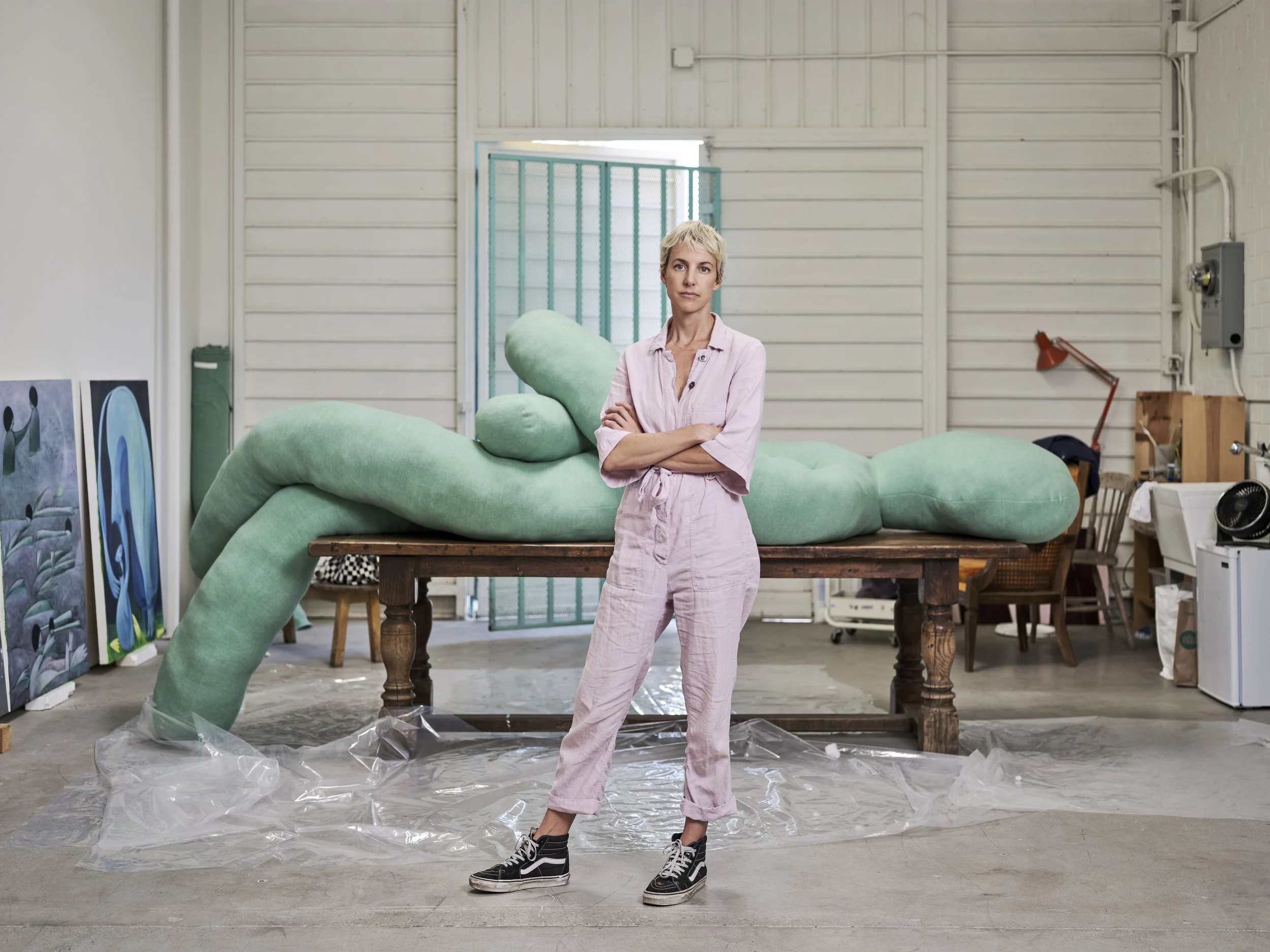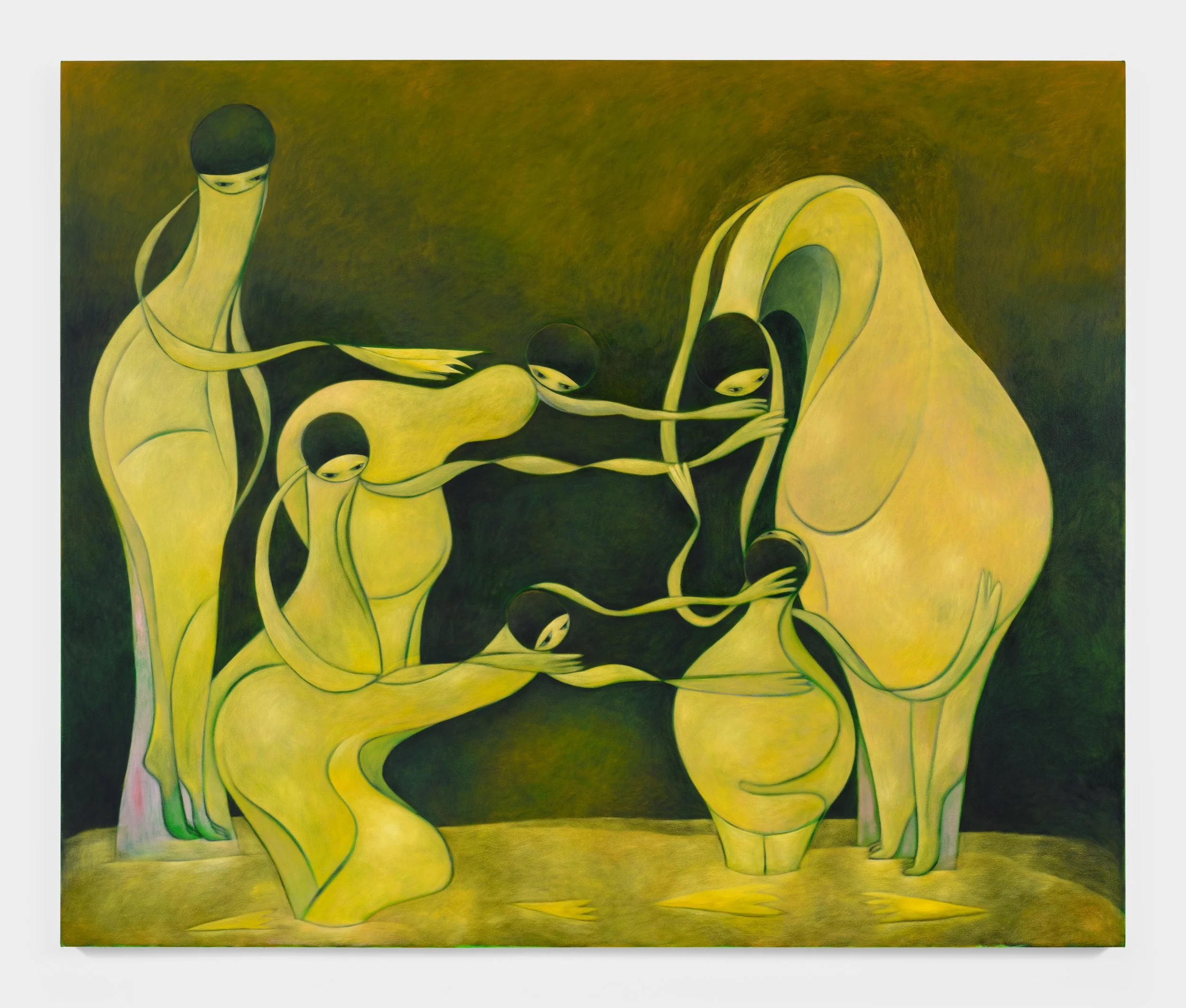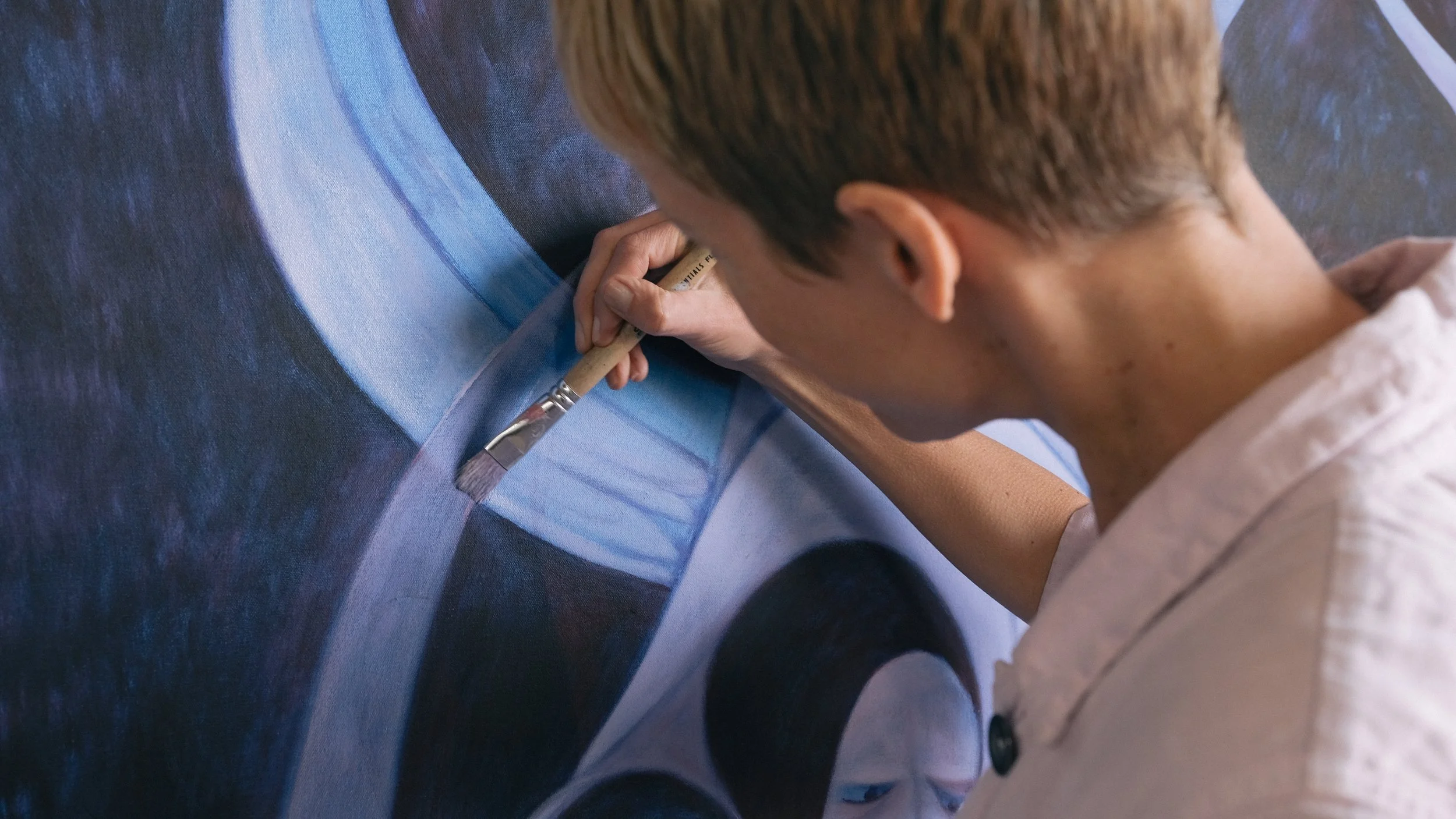TAHNEE LONSDALE
ANGELS WITHOUT THE CLICHE
By Meredith Shepard
Even before I met Tahnee Lonsdale, before I knew that her work is interested in otherworldly beings, I was thinking about aliens. Not because her painted figures reminded me of the extraterrestrial, but because they are so unusual in the contemporary art scene that if aliens came to earth and saw only Lonsdale’s work, they would return to outer space with a message about art that really only applies to her, unless one goes back to Matisse and Picasso. The message would go something like this: great art is made when you paint humans out of basic shapes and contrasting colors. That’s it. No context, no cultural signs, no microscopic details, no music in the background. No explicit politics. Nobody we know. Just human-esque figures shaped out of triangles and ovals and squares, colored in blue and red, or yellow and green, or blue and blue. What a simple recipe! And yet–how gargantuan the impact.
I’ve had Lonsdale’s website up on my phone for weeks and I dive in whenever I need to escape life’s ugly fluorescence–the pharmacy line or muted Zoom call. When I do, I feel like I did as a student walking for the first time into the Rothko Room at London’s Tate Modern, where the dim lighting and the strange gloaming of his earthen colors make me wonder if they drugged the museum air. Like Rothko, Lonsdale’s paintings slow the heartbeat until you almost feel like you’re next to your own heart–rust-red organ pumping away–with all the uncanny yet euphoric sensations that proximity induces. It’s not so much that Lonsdale’s works “get under your skin” the way that slier, more conceptual works do. It’s that in looking at them, you find yourself suddenly waking up under your own skin. She lifts the hood on the engine of the familiar (people; basic shapes and colors), and what you find there is both as comfortable as your own mother, and totally alien. Who or what are these human yet otherworldly forms?
Tahnee Lonsdale portrait inside the artist’s Los Angeles studio. Courtesy of the artist. Image: Phil Cheung.
Tahnee Lonsdale, Unfathomable, 2023. Acrylic on canvas, 70 x 84 in. Courtesy of the artist.
When Lonsdale talks about the “otherworldly,” the “celestial,” or the “divine,” terms that recur across her press materials, she is referring to what she describes to me as “angels without the cliche.” It is emphatically not a religious thing; her interest lies in the unknown, whether that exists “in the unknown realms of our planet,” like so-called UFOs, or in the “unknown realms of our consciousness.” It doesn’t matter to her whether aliens are real or a concept, or whether our ideas arrive from other planetary worlds or from the other worlds within ourselves. Either way, what’s important to Lonsdale is that some things operate on an unknown plane, and that that plane intersects with our lives through spirituality, meditation, or–for her–art. Appropriately, the figures that have dominated Lonsdale’s paintings since 2020 “just arrived” without conscious origin, and keep “returning in slightly different form.”
“the idea that things don't form until you observe them. They're just potential, like, atoms…until you observe them and choose to see them.”
After all, she moved to Los Angeles with her now ex-husband and two young children in 2015, when her only “studio” was a family living room, and her medium was packing boxes. The paintings of those years are cramped and cluttered, filled with figures whose body parts are dismembered or eerily merged with other beings, representative of a mother stretched too thin as she tends to needy bodies. Lines of breasts evocative of cow udders suggest the exhausted self-replication of breastfeeding in still, life (2017) and me as you (2017), while the painting my self, your shelf with its woman contorted into a table expresses rage with no possibility of escape from imprisoned domesticity. Of that time, she remembers “finding figures within anything I could see…I was looking at objects and they were becoming figures.” This memory takes her to a fascinating spell down Los Angeles streets–not the romanticized boulevards of Hollywood but the trash and debris:
“In LA, there’s so much dumped furniture on the side of the road, people just put their couches out in the street, and I would take pictures of it. And then it would anthropomorphize itself into my paintings, becoming these large oafish figures entwined. And it started to represent this idea of fucked up domesticity around a marriage breaking up and the way I was so angry about how women are dumped like furniture is dumped at the side of the road, and it’s quite sexual, because these sofas would be on top of each other. And then in my paintings it would be this intertwining; quite grotesque and twisted. It was not a very romantic time for my paintings. But they were definitely telling me something that I wasn't quite ready to hear.” Listen she did. It is only when Lonsdale divorced and got her own studio in 2018 and 2019 that her paintings declutter and expand, replacing cramped body parts with entwining, exploratory figures. Some of these early large figures articulate what she calls the awkwardness of early dating, that clumsy embrace of figures who look lovely but don’t seem to know what to do with their bodies.
Tahnee Lonsdale inside the artist’s Los Angeles studio. Courtesy of the artist. Image: Emma Marie Jenkins, Avant Arte.
As Lonsdale gained autonomy in her personal life, her paintings gained space. By 2020, the figures are large and straight-postured enough to look like people in control of their situation, or of gods on earth who know what they’re doing. And yet, there is still something melancholy in their eyes, the downward slant of their look, the “grief-laden gaze” that Lonsdale acknowledges as carrying generations of women’s and mothers’ suffering. She recently participated in a ceramics residency in Guadalajara, and when she protested to the committee that invited her that she’s not a ceramicist, they responded that her figures are vessels. “They’re like containers,” Lonsdale reflects. “We carry this heritage, we carry grief, we carry memories, we carry trauma, we carry memories…many generations of what I can say is female grief.” She pauses, then continues. “When my mother was in her mother's womb, my mother was already carrying the eggs to have me. It’s this Russian doll thing, how we each contain the previous and the next.”
Ash Rays, 2023. Oil on canvas, 48 x 36 in. Courtesy of the artist.
I See You, 2022. Oil on canvas, 40 x 30 in. Courtesy of the artist.
“We carry this heritage, we carry grief, we carry memories, we carry trauma, we carry memories…many generations of what I can say is female grief.”
The transgenerational layering of maternity and womanhood is an act of carrying in the supportive sense, but also in the transmission of grief and fear. The maternal gesture depicted in ash rays (2023) and i see you (2022) is universal: a motherly figure’s rounded arm curving around the child figure in support, love, and enclosure, protecting the child at the same time as the mother’s eyes are filled with all that she has to protect against. “On a micro level as mothers, we fear for the future of our kids, and we fear the future of our planet. And just, there's a lot of fear, because there's not much support. And on a macro level, the burdens of previous generations go many, many, many times back, and whether they end on this planet, or whether they began long before, it's just an unknown, isn't it?” Lonsdale’s celestial beings show what love looks like as it faces off against unknown and infinite threat. What could be more earthly or more divine? The weeping god. The luminous mourner. The citizens bent yet rising.
Tahnee Lonsdale painting in the studio. Courtesy of the artist. Image: Emma Marie Jenkins, Avant Arte.
Far from being disconnected from the material and autobiographical, however, the evolution of Lonsdale’s figures track her autobiography. This doesn’t seem a paradox to her, and to make sense of it myself I turn to her interest in what she calls the spiritual side of quantum physics, “the idea that things don't form until you observe them. They're just potential, like, atoms…until you observe them and choose to see them.” I remark that I’d recently read that we humans are made up of about six teaspoons of atoms; the rest is just empty space. But what are the politics of that…emptiness, I wonder? Lonsdale is optimistic but also pragmatic; it “makes you realize the power of your thought…of creativity. If you can’t see anything, you can be in blissful ignorance, but as soon as you see, you have the responsibility to do something.” I ask her if she thinks her art helps people “see” in that sense of awakening responsibility, if there’s anything activist-y about her work. She demurs. “I wouldn’t want to give myself that much power.” The only impact she can acknowledge of her paintings is on how the viewer feels. An old fashioned sentiment, but I can’t help but wonder if the paintings allowed Lonsdale to see her own life, and in seeing it, discover the responsibility to do something about it.
Tanhee Lonsdale, To Honor and Obey, 2017. Acrylic on canvas, 66 x 77 in. Courtesy of the artist.







